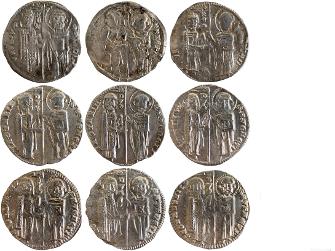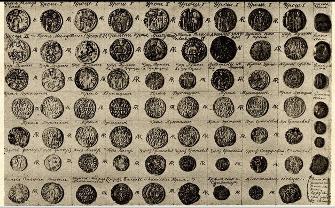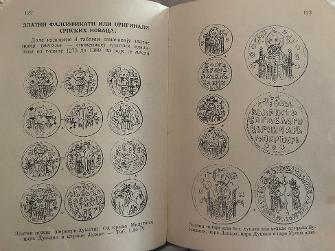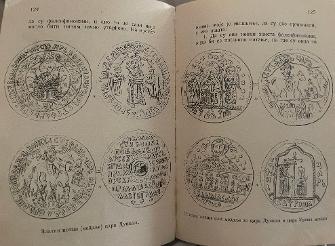SERBIAN MEDIEVAL COINS PUBLISHED IN THE ILLUSTRATED LIST IN 1921
In the illustrated list in 1921, a total of 70 coins were published, which can be seen here in the attached picture. (Picture 1).
In the first row, the first coin is described as a coin of "King Vladislav", but it is the standing type of King Dragutin 1276-1282, then there are 8 coins of the matapan type of King Uroš I 1243-1276, with the fact that the fifth coin in the first row with a cross on the handle is the coin of King Milutin 1282-1321. The coins at the end of each row is not very well visible and it is not clear what they are.
In the second row, there are first three seated variants of King Milutin, then two coins of King Dušan 1331-1346 described as money of "King Dragutin of Srem", one type of King Vladislav II 1321-1324, one coin that is not very visible with the description "Dušan's gold coin", a helmet type of Dušan as king and an imperial type with a description in four lines of Emperor Dušan 1346-1355.
Only 19 years later Negovan P. Rajić In 1940, in the book "Illustrated catalogue of coins of Serbian emperors, kings, princes, despots, grand princes and other Serbian dignitaries", published several drawings of "Dušan" and others gold coins on pages 122-125. He even posted his address and invited anyone who wanted to come and see in person the gold coin he owned. Below is a image of a gold coin with a hole similar to the gold coin drawing on page 123. (Pictures 2).
Based on the coin's design and how it differs from the style of medieval Serbian moneyers, my opinion is that these are forgeries from the 19th and 20th century. (Pictures 3 and 4).
In the third row from the picture from the Illustrated list are three variants of Emperor Dušan on horseback and three standing variants of the imperial couple Dušan and Jelena. The seventh coin is the Kotor seated type of Emperor Dušan and the last two are the helmet and the seated type of Emperor Uroš 1355-1371.
In the fourth row there are nine and in the fifth row seven coins of the type with a description in five lines of King Vukašin Mrnjavčević 1365-1371. At the end of the fifth row are two coins, a type with a description in two lines and with a running lion, of the nobleman Vuk Branković 1371-1397.
In the sixth row are two more coins, a type with a description in three lines, of the nobleman Vuk Branković, two coins, standing type and helmet type, of prince Lazar 1371-1389, three types, with lion, with description in four lines and monogram type, of despot Đurađ Branković 1427-1456 and two coins described as money of "Djuradj Skenderbeg - Branković" who fought against the Turks 1443-1468 whose Branković origin is indicated here and whose coin was described as a Serbian coin in 1921. In any case, it is not known that Skanderbeg minted coins, and this standing type looks more like Prince Lazar's coins to me, especially the Latin type minted in Novi Brdo, posthumously, which means after Lazar's death in the battle in Kosovo, during the reign of Princess Milica as regent 1389-1393.
In the last seventh row, the first two coins are a standing type of the despot Stefan Lazarevic 1402-1427, a coin with a description in five lines of the grand prince Nikola Altomanović 1363-1373, three helmet with a wolf type of Balša III Balšić 1403-1421 and three Hungarian coins.
The description in the Illustrated list reads: "Old Serbian coins. Reverse view. From the collection of Mr. D. B. Bogdanović, Priština. This collection of Serbian coins abounds in beautifully preserved specimens. One part of the collection, during the evacuation Mr. Bogdanović gave to the Ministry of Education for the National Museum in Corfu, and the other part of the collection, which is still the property of Mr. Bogdanović, is now also offered for purchase for the National Museum."
I hope that these coins ended up in the National Museum, Belgrade, Serbia.
Images of the coins from the Illustrated list were provided by Goran Šterjoski Štera.





























